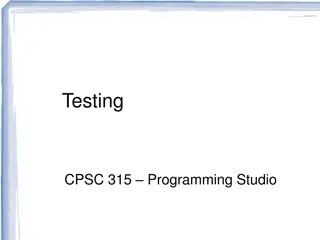Understanding Gray Box Testing in Software Development
Gray Box Testing is a software testing technique that involves testing the software with partial knowledge of its internal workings. It combines aspects of White Box Testing and Black Box Testing, allowing testers to check both the presentation layer and the code part of an application. Gray Box Testing provides benefits such as improved product quality, reduced testing overhead, and a user-centric testing approach. Testers do not require access to the source code to perform Gray Box Testing; tests are designed based on knowledge of the program's behavior. This testing method is especially useful for Integration Testing and Penetration Testing, enabling the identification of context-specific errors in web systems.
Download Presentation

Please find below an Image/Link to download the presentation.
The content on the website is provided AS IS for your information and personal use only. It may not be sold, licensed, or shared on other websites without obtaining consent from the author. Download presentation by click this link. If you encounter any issues during the download, it is possible that the publisher has removed the file from their server.
E N D
Presentation Transcript
Grey Box Testing L12 2020
What is Gray Box Testing? Gray Box Testing is a technique to test the software product or application with partial knowledge of the internal workings of an application. In this process, context specific errors that are related to web systems are commonly identified. It will increase the testing coverage by concentrating on all of the layers of any complex system.
Combination of White-box and Black-box Gray Box Testing is a software testing method, which is a combination of both White Box Testing and Black Box Testing method. In White Box testing internal structure (code) is known In Black Box testing internal structure (code) is unknown In Grey Box Testing internal structure (code) is partially known
Gray Box Testing gives the ability to test both sides of an application, presentation layer as well as the code part. It is primarily useful in Integration Testing and Penetration Testing.
Example of Gray Box Testing While testing websites feature like links or orphan links, if tester encounters any problem with these links, then he can make the changes straightaway in HTML code and can check in real time.
Why Gray Box Testing Gray Box Testing is performed for the following reason, It provides combined benefits of both black box testing and white box testing both It combines the input of developers as well as testers and improves overall product quality It reduces the overhead of long process of testing functional and non-functional types It gives enough free time for developer to fix defects Testing is done from the user point of view rather than designer point of view
Gray Box Testing Strategy To perform Gray box testing, it is not necessary that the tester has the access to the source code. Test are designed based on the knowledge of algorithm, architectures, internal states, or other high -level descriptions of the program behavior.
To perform Gray box Testing It applies straight forward technique of black box testing It is based on requirement test case generation, as such it presets all the conditions before the program is tested by assertion method.
Techniques used for Grey box Testing Matrix Testing: This testing technique involves defining all the variables that exist in their programs. Regression Testing: To check whether the change in the previous version has regressed other aspects of the program in the new version. It will be done by testing strategies like retest all, retest risky use cases, retest within firewall. Orthogonal Array Testing or OAT: It provides maximum code coverage with minimum test cases. Pattern Testing: This testing is performed on the historical data of the previous system defects. Unlike black box testing, gray box testing digs within the code and determines why the failure happened
Usually, Grey box methodology uses automated software testing tools to conduct the testing. Stubs and module drivers are created to relieve tester to manually generate the code.
Steps to perform Grey box Testing Step 1: Identify inputs Step 2: Identify outputs Step 3: Identify major paths Step 4: Identify Subfunctions Step 5: Develop inputs for Subfunctions Step 6: Develop outputs for Subfunctions Step 7: Execute test case for Subfunctions Step 8: Verify correct result for Subfunctions Step 9: Repeat steps 4 & 8 for other Subfunctions Step 10: Repeat steps 7 & 8 for other Subfunctions
The test cases for grey box testing may include, GUI related, Security related, Database related, Browser related, Operational system related, etc.
Gray Box Testing Challenges When a component under test encounter a failure of some kind may lead to abortion of the ongoing operation When test executes in full but the content of the result is incorrect.
Summary The overall cost of system defects can be reduced and prevent from passing further with Grey box testing Grey box testing is suited more for GUI, Functional Testing, security assessment, web applications, web-services, etc. Techniques used for Grey box Testing Matrix Testing Regression Testing OAT or Orthogonal Array Testing Pattern Testing























